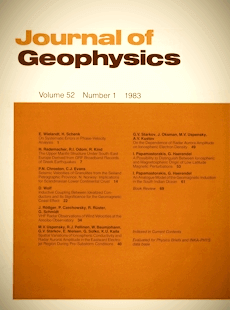Earth's flattening effect on the tidal forcing field
Article Sidebar

Vols. 1-18 (1924-1944), ISSN 0044-2801
Main Article Content
Abstract
A small part of the tidal forcing field whose contribution is omitted in the conventional spherical harmonic development of the tidal potential is caused by the flattening of the Earth. It is a homogeneous tidal field of magnitude of about 1 ngal superposed on the commonly known tidal forcing field. The conventional tidal forcing field can be completely described by the spatial variation of the gravity field of the tide-generating body within the space occupied by the Earth. The advantage of this description is that any reference to the Earth's motion with respect to the tide-generating body (called revolution without rotation) can be avoided.
 ARK: https://n2t.net/ark:/88439/y033803
ARK: https://n2t.net/ark:/88439/y033803
Permalink: https://geophysicsjournal.com/article/193
Article Details
References
Jung, K. (1955) Uber die Darstellung der Gezeitenkrafte, Gerlands Beitr. Geophys. 64:278-283
Heiskanen, W., Moritz, H. (1967) Physical geodesy. Freeman, San Francisco
Kaula, W.M. (1968) Introduction to planetary physics. Wiley & Sons, New York
Muller, I.I. (1980) Bulletin Geodesique, Vol. 54, No. 3, Paris
Wahr, J.M. (1979) The tidal motions of a rotating, elliptical, elastic and oceanless earth, Ph.D. Thesis, University of Colorado, USA
Wahr, J.M. (1981) Body tides on an elliptical, rotating, elastic and oceanless earth, Geophys. J. R. Astron. Soc. 64:677-703











